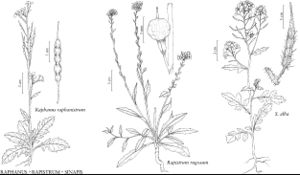Raphanus
Sp. Pl. 2: 669. 1753.
Gen. Pl. ed. 5, 300. 1754.
| Taxon | Illustrator ⠉ | |
|---|---|---|
 | Raphanus raphanistrum Rapistrum rugosum Sinapis alba | Yevonn Wilson-Ramsey Yevonn Wilson-Ramsey Yevonn Wilson-Ramsey |
Annuals or biennials; (roots slender or fleshy, size, shape, and color variable in cultivated forms); not scapose; glabrous or pubescent. Stems erect, unbranched or branched. Leaves basal and cauline; petiolate or subsessile; basal not rosulate, petiolate, blade margins lyrately lobed or pinnatifid to pinnatisect; cauline shortly petiolate or subsessile, blade (base not auriculate), margins dentate or lobed, (smaller and fewer-lobed than basal). Racemes (corymbose, several-flowered), usually greatly elongated in fruit. Fruiting pedicels divaricate, ascending, or spreading [reflexed]. Flowers: sepals erect, narrowly oblong [linear], lateral pair slightly saccate basally; petals white, creamy white, yellow, pink, or purple [lilac] (usually with darker veins), broadly obovate [suborbicular], claw differentiated from blade, (± longer than sepals, apex obtuse or emarginate [rounded]); stamens strongly tetradynamous; filaments not dilated basally; anthers oblong or oblong-linear, (apex obtuse); nectar glands (4), median pair present. Fruits siliques or silicles, indehiscent, sessile, segments 2, (lomentaceous, often breaking into 1-seeded units), cylindrical, fusiform, lanceolate, or ovoid, [linear, oblong, ellipsoid], smooth or torulose to strongly moniliform, (constricted or not between seeds), terete or polygonal; (valvular segment seedless, rudimentary, or aborted, nearly as wide as pedicel; terminal segment several-seeded, corky); valves glabrous, antrorsely scabrous, or hispid; replum and septum not differentiated; ovules 2–22 per ovary; (style slender); stigma capitate, slightly 2-lobed. Seeds uniseriate, plump, not winged, oblong, ovoid, or globose [subglobose]; seed-coat (nearly smooth to reticulate), not mucilaginous when wetted; cotyledons conduplicate. x = 9.
Distribution
Introduced; Eurasia, also nearly worldwide
Discussion
Species 3 (2 in the flora).
Natural hybridization between Raphanus raphanistrum and R. sativus has been known since 1788, and the hybrid has been named R. ×micranthus (Uechtritz) O. E. Schulz. The transfer of some of the weedy characters from R. raphanistrum to R. sativus through natural hybridization may have played a major role in converting the latter from a crop plant into a successful weed near the coastal areas of central California (C. A. Panetsos and H. G. Baker 1968). Raphanus confusus (Greuter & Burdet) Al-Shehbaz & Warwick is known from Asia (Israel, Lebanon).
Selected References
None.
Lower Taxa
Key
| 1 | Petals pale or creamy white; fruits (2.5-)3-8(-11) mm wide, strongly constricted between seeds and usually breaking, strongly ribbed, beak narrowly conical. | Raphanus raphanistrum |
| 1 | Petals usually purple or pink, sometimes white; fruits (5-)7-13(-15) mm wide, rarely slightly constricted between seeds and usually not breaking, not ribbed, beak narrowly to broadly conical to linear. | Raphanus sativus |
"elongated" is not a number."thick" is not a number.